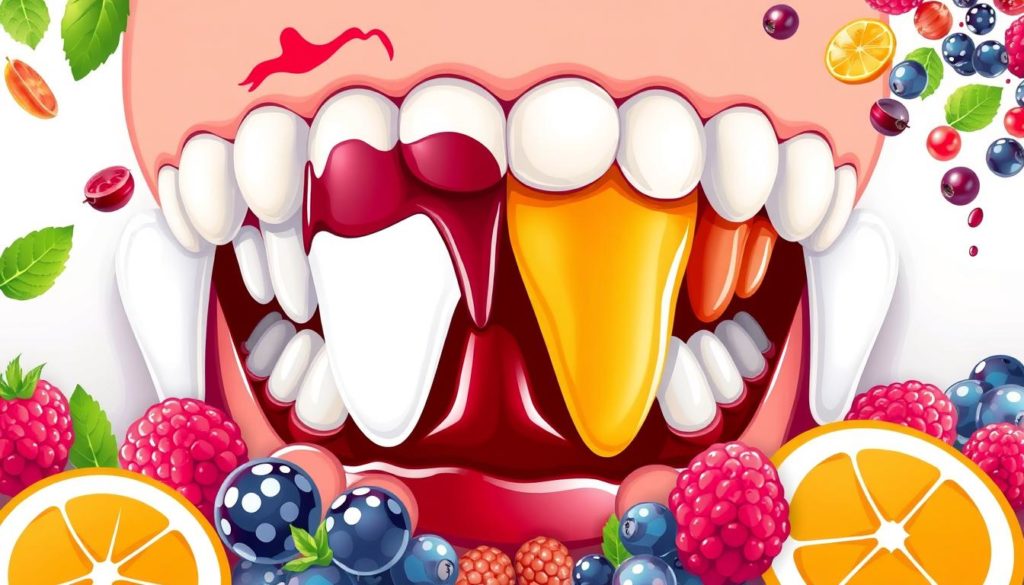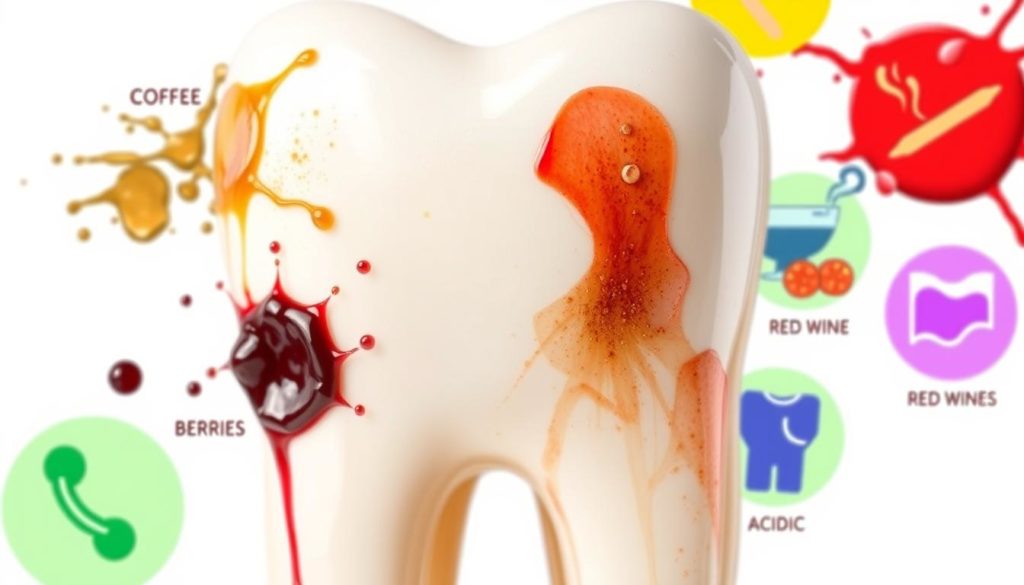Did you know nearly 18% of Americans hide their smile in photos because of tooth discoloration? Yellow teeth can really hurt your confidence, making you shy away from smiling.
Having a bright smile is more than just looking good. It’s about feeling confident too. Things like what you eat, your habits, and even some medicines can make your teeth look less white. But, the bright side is there are many ways to get your teeth shining again.
In this article, we’ll look at why teeth get discolored, how to prevent it, and the treatments that can help. So, get ready to say goodbye to tough stains and hello to a brighter smile!
Understanding Tooth Discoloration
Tooth discoloration means your teeth don’t look their natural color. This can make you worry about how your smile looks. It might show as spots or a change in color that lowers your confidence.
What is Tooth Discoloration?
Tooth discoloration is when your teeth don’t stay their natural color. It can happen for many reasons like getting older, what you eat, or not brushing well. Knowing the cause helps find the right way to fix it.

Types of Tooth Discoloration
There are two main kinds of tooth discoloration: intrinsic and extrinsic.
- Intrinsic Tooth Discoloration: This comes from inside the tooth. It can be from tooth damage, some medicines, or too much fluoride when you’re young.
- Extrinsic Tooth Discoloration: This is on the outside of the tooth. It’s usually from stains like coffee, tea, red wine, smoking, and some foods.
Knowing the difference between intrinsic and extrinsic discoloration is key. It helps you choose the right treatment and how to keep your smile bright. Whether it’s just a stain or a deeper issue, making smart choices can improve your smile.
Common Causes of Stained Enamel
To keep your smile bright, let’s explore what causes stains on teeth. These include daily habits and choices that lead to dental discoloration and enamel stains.

Food and Drinks
Many foods and drinks can stain your teeth. Coffee, tea, red wine, and berries are examples. They have chromogens that stick to your enamel, causing stains. Being careful with these can help prevent dental discoloration.
Tobacco Use
Tobacco products are a major cause of stains. Nicotine and tar in cigarettes and chewing tobacco damage your enamel. This leads to yellow and brown stains. Quitting tobacco improves your health and reduces stain risk.
Medications
Some medications can also cause tooth stains. Antibiotics like tetracycline and doxycycline can permanently stain teeth. This is especially true for young teeth. Always talk to your doctor about the risk of enamel staining from medications.
Prevention Tips for a Brighter Smile
To keep your smile shining, it’s important to follow some key prevention tips. These should be part of your daily routine. A good dental care routine can help prevent tooth discoloration. Here’s how you can do it:
Daily Oral Hygiene
Keeping your teeth clean is a must. Brushing twice a day with fluoride toothpaste, flossing every day, and using mouthwash helps. These steps are crucial in preventing yellow or stained teeth.
Dietary Changes
Choosing the right foods is also important. Stay away from foods and drinks that stain teeth, like coffee and red wine. Eat crunchy fruits and veggies instead. They clean your teeth naturally. Drinking water also helps by washing away food particles.
Regular Dental Checkups
Don’t skip your dental checkups. They are key to your dental health. Dentists can clean your teeth better than you can at home. These visits help keep your smile bright and healthy.
| Prevention Tip | Action | Benefit |
|---|---|---|
| Daily Oral Hygiene | Brush, Floss, Mouthwash | Removes plaque and surface stains |
| Dietary Changes | Avoid high-staining foods | Reduces risk of stains |
| Regular Dental Checkups | Professional cleanings | Removes tartar and calculus |
At-Home Remedies for Yellow Teeth
Many people want to brighten their smiles without spending a lot. Luckily, there are at-home remedies that use common household items. These DIY teeth treatments are easy to try.
Mixing baking soda and hydrogen peroxide is a popular method. This combo makes a paste that gently removes stains from your teeth.
Oil pulling with coconut oil is another favorite. It involves swishing oil in your mouth to remove bacteria and stains. This might make your teeth look whiter over time.
Using fruit peels, like banana and orange, is also a natural way to whiten teeth. Rubbing the inside of the peel on your teeth can give a mild bleaching effect.
- Baking Soda and Hydrogen Peroxide
- Oil Pulling with Coconut Oil
- Banana and Orange Peels
Let’s look at how these DIY teeth treatments compare:
| Remedy | Ingredients | Potential Benefits | Considerations |
|---|---|---|---|
| Baking Soda and Hydrogen Peroxide | Baking Soda, Hydrogen Peroxide | Effective for surface stains | Use sparingly to avoid enamel damage |
| Oil Pulling | Coconut Oil | Removes impurities and bacteria | Results may take time |
| Fruit Peels | Banana, Orange Peels | Natural bleaching agents | Limited scientific evidence |
These methods might help brighten your smile. But, it’s key to have realistic hopes and know the limits of at-home remedies.
Over-the-Counter Whitening Products
Choosing the right over-the-counter teeth whitening product can make a big difference. Let’s explore the most popular choices, their whitening products effectiveness, and how to use them for the best results.
Whitening Toothpaste
Whitening toothpaste is simple to add to your daily routine. It has mild abrasives and chemicals like hydrogen peroxide. These help remove surface stains. It’s great for keeping your smile bright over time.
Whitening Strips
Whitening strips are popular and easy to find. They offer a big boost in whitening products effectiveness. The strips have a gel with peroxide that bleaches stains on the enamel. You’ll see results in a couple of weeks with regular use.
Whitening Gels and Trays
Whitening gels, used with trays, are another good at-home option. These gels have strong bleaching agents to remove deep stains. Used right, they can be as effective as professional treatments.
Professional Whitening Options
Professional whitening treatments can change your smile. They are part of cosmetic dentistry and give better results than home kits. We’ll look at in-office treatments and dentist-supervised take-home kits.
In-Office Treatments
Dentists do in-office whitening. They use a strong bleaching agent and sometimes lights or lasers. This makes teeth whiter faster.
- Procedure: First, the dentist protects your gums. Then, they apply the bleaching agent. Lights or lasers may be used to speed up the whitening.
- Results: You’ll see your teeth get much brighter. They can lighten several shades in one visit.
Take-Home Kits from Dentists
Take-home kits are for those who can’t get to the dentist. They are made for your teeth and have strong bleaching gel.
- Procedure: Your dentist makes custom trays for your teeth. They give you the gel and show you how to use it at home.
- Results: It takes longer than in-office treatments, but you’ll see a difference in a few weeks. You can whiten your teeth at your own pace.
Here’s a quick comparison of in-office treatments versus take-home kits:
| Aspect | In-Office Treatments | Take-Home Kits |
|---|---|---|
| Professional Supervision | Yes, direct supervision during the procedure | Yes, initial supervision with ongoing self-application |
| Time to Results | Immediate, within a single session | Gradual, over several weeks |
| Convenience | One-time, requiring a scheduled appointment | Flexible, can be used at home at your convenience |
These professional whitening options give you the best care and results. They are key in modern cosmetic dentistry.
Cosmetic Dentistry Solutions
Looking for something other than traditional teeth whitening? Cosmetic dentistry has many effective solutions to change your smile. Techniques like veneers and dental bonding help fix different dental issues and make your teeth look better.
Veneers
Veneers are thin, custom-made shells for your teeth. They’re made of porcelain or composite resin. They’re great for fixing stains, chips, or gaps. The process is quick and doesn’t hurt much.
With the right care, veneers can last a long time. They make your smile look natural and beautiful.
Bonding
Dental bonding uses a tooth-colored resin to fix teeth. It’s molded, hardened, and polished to match your teeth. It’s good for fixing chips, stains, or gaps.
This method is fast and affordable. You can see the results right away, in just one visit.
| Cosmetic Dentistry Solution | Material | Common Uses | Benefits |
|---|---|---|---|
| Veneers | Porcelain or Composite Resin | Discoloration, Chips, Gaps | Durable, Natural-Looking, Minimally Invasive |
| Dental Bonding | Tooth-Colored Resin | Chipped Teeth, Discoloration, Gaps | Quick, Cost-Effective, Immediate Results |
Exploring cosmetic dentistry solutions like veneers and dental bonding can give you a brighter smile. These options are tailored to fix various dental problems. They boost your confidence and improve your dental health.
Natural Ingredients for Teeth Whitening
The trend towards organic dental care is growing. People are looking for natural ways to whiten their teeth. Let’s explore some popular ingredients used for natural teeth whitening.
These natural ingredients offer a holistic way to keep your smile bright. They do this without harsh chemicals:
- Activated Charcoal: Charcoal can bind to toxins and lift stains from teeth. But, it’s abrasive, so use it carefully to avoid enamel damage.
- Turmeric: Turmeric might seem odd because it’s yellow. But, it’s valued in organic dental care for whitening teeth and boosting oral health.
- Coconut Oil: Coconut oil is used in oil pulling. It’s believed to remove plaque and bacteria, making teeth whiter and breath fresher.
Here’s a quick look at the pros and cons of these natural ingredients:
| Ingredient | Benefits | Drawbacks |
|---|---|---|
| Activated Charcoal | – Removes surface stains – Detoxifies mouth | – Abrasive, can harm enamel with frequent use |
| Turmeric | – Anti-inflammatory – Antimicrobial | – Requires consistent use – May taste unpleasant |
| Coconut Oil | – Reduces plaque – Freshens breath | – Time-consuming – Not immediately effective |
Using these organic dental care methods can help achieve safe teeth bleaching naturally. Always talk to a dental professional before starting any whitening routine. This ensures your teeth stay healthy and safe.
Risks and Side Effects of Whitening Treatments
Teeth whitening treatments can make your smile brighter. But, they come with some risks. It’s important to know about the possible side effects before starting. Common issues include dental sensitivity and gum irritation, which might not be worth the brighter smile.
Sensitivity
Increased dental sensitivity is a common side effect. This happens when the enamel is damaged during whitening, exposing the dentin. People might feel pain when eating or drinking hot or cold things. To avoid this, don’t overdo the whitening treatments.
Gum Irritation
Gum irritation is another common issue. It’s caused by whitening agents touching the soft tissue. This can lead to redness, swelling, and even bleeding. To prevent this, follow the instructions carefully and talk to a dentist before starting any whitening treatment.
| Issue | Description | Prevention Tips |
|---|---|---|
| Dental Sensitivity | Discomfort or pain in teeth when exposed to hot or cold stimuli. | Limit the frequency of whitening treatments and use a sensitivity toothpaste. |
| Gum Irritation | Redness, swelling, or bleeding in the gum area. | Ensure whitening agents do not come into contact with gums during application. |
Choosing the Right Whitening Method for You
Choosing the right whitening method means looking at a few key things. You need to think about how bad your stains are, how much you want to spend, and your lifestyle. A plan made just for you can lead to the best results. Some people might just need something from the store, while others need a dentist’s help.
First, check how bad your stains are. If they’re just a little off, you might use whitening toothpaste or strips. But if they’re really bad, you might need something stronger from a dentist. Also, think about your budget. Professional treatments cost more but last longer and work faster than store-bought stuff.
Talking to a dentist can really help. They can check your teeth and tell you the best way to whiten them. They might suggest veneers, bonding, or even natural ways to brighten your smile. Getting a brighter smile is easier with the right advice.
FAQ
What is Tooth Discoloration?
Tooth discoloration is when your teeth change color. This can be a light yellow to dark brown spots, white streaks, or even grey or black.
What causes stained enamel?
Stained enamel comes from eating foods and drinks with chromogens, smoking, and some medicines. Aging and genetics also play a role.
Are there different types of tooth discoloration?
Yes, there are two types. Intrinsic discoloration is inside the tooth. Extrinsic discoloration is on the tooth’s surface.
How can I prevent tooth discoloration?
To prevent discoloration, brush well, avoid stain-causing foods and drinks, don’t smoke, and see your dentist regularly.
What are some at-home remedies for yellow teeth?
Home remedies include baking soda and hydrogen peroxide, oil pulling, and banana peels. They might work but results vary.
What over-the-counter whitening products are available?
You can find whitening toothpaste, strips, gels, and trays over the counter. They often have hydrogen peroxide or carbamide peroxide.
What professional whitening options are available?
Dentists offer in-office whitening and take-home kits. These are stronger and more effective than what you can buy over the counter.
What cosmetic dentistry solutions can help with tooth discoloration?
Cosmetic dentistry offers veneers and dental bonding. Veneers are thin shells, and bonding uses resin on the tooth’s surface.
Are there natural ingredients for teeth whitening?
Yes, natural ingredients like charcoal, turmeric, and oils can whiten teeth. But, their safety and effectiveness vary, so be careful.
What are the risks and side effects of whitening treatments?
Whitening can cause tooth sensitivity and gum irritation. Always follow instructions and talk to a dentist to avoid these issues.
How do I choose the right whitening method for me?
Consider how stained your teeth are, your budget, lifestyle, and oral health. A dentist can help you decide what’s best.


